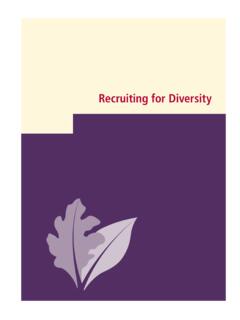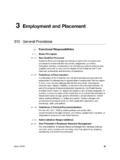Transcription of Diversity, Inclusion and Equity Toolkit
1 diversity , Inclusion and Equity Toolkit Developed by PILOT Table of Contents Glossary of Terms .. i - iv Instructions for Assessment .. 1 Assessment .. 3 Scoring Guide .. 17 Appendix A: Discussion Guide .. 18 Appendix B: diversity and Inclusion action Plan Template .. 20 Appendix C: Sample diversity , Inclusion and Equity Statement .. 21 Appendix D: Recommended Reading .. 22 Appendix E: Acknowledgements .. 23 diversity , Inclusion and Equity Toolkit PILOT Created by: Rosemary Linares, NEW Katena Cain, Nonprofit Network Diana Kern, NEW Regina Funkhouser, Nonprofit Network *The Stronger Communities diversity and Inclusion Pilot Project intentionally focuses on the perspectives of the organization s executive director and board leadership.
2 Plans are underway to apply a comprehensive, holistic approach to this work, recognizing that change of this nature is most effective when the entire organization is involved including staff, the executive director and the board. GLOSSARY OF TERMS i 1. diversity - Being composed of a demographic mix of an intentional collection of people, taking into account elements of difference across national origins, languages, ethnicities, races, skin colors, cultures, generations, religions, spiritualities, socio-economic backgrounds, gender identities and sexual orientations, as well as different skills, abilities, customs, values, behavioral styles and a) Race and Ethnicity: Race refers to a person s physical appearance and ethnicity refers to one s nationality, ancestry, culture, and language.
3 In 1997, the Office of management and Budget designated Hispanic/Latino as an ethnicity category, separate from race, which included American Indian or Alaska Native, Asian, Black or African American, Native Hawaiian or Other Pacific Islander, and White. b) Sexual Orientation: refers to an individual s physical and/or emotional attraction to the same and/or opposite ) Gender identity: refers to a person s internal sense of being male, female or something else, which may or may not correspond to the person s body or designated sex at birth (meaning what sex was originally listed on a person s birth certificate). Transgender is an umbrella term for people whose gender identity, expression or behavior is different from those typically associated with their assigned sex at birth, including but not limited to transsexuals, cross-dressers, androgynous people, and gender non-conforming people.
4 Intersex refers to a sex assigned at birth for individuals exhibiting characteristics (such as reproductive or sexual anatomy and/or chromosomes) of both birth-assigned males and females. Different sexual orientations can include, lesbian, gay, bisexual, queer, questioning, or straight. iiid) Dis/ability: refers to a variety of individuals who may or may not use this specific term to describe themselves or their experiences, encompassing a broad range of dis/abilities that may be perceptual, illness-related, physical, developmental, psychiatric, mobility-related or environmental. e) Age: refers to the length of time that one has existed on the planet, their duration of life.
5 F) Class: refers to a group of persons sharing a similar social position and certain economic, political, and cultural characteristics. Social class is a status hierarchy in which individuals and groups are classified on the basis of esteem and prestige acquired mainly through economic success and accumulation of g) Religion/Spirituality: refers to human beings relation to that which they regard as holy, sacred, absolute, spiritual, divine, or worthy of especial reverence. It is also commonly regarded as consisting of the way people deal with ultimate concerns about their lives and their fate after death. In many traditions, this relation and these concerns are expressed in terms of one s relationship with or attitude toward god(s) or spirits; in more humanistic or naturalistic forms of religion, they are expressed in terms of one s relationship with or attitudes toward the broader human community or the natural Spirituality is an individual s understanding of, experience with, and connection to that which transcends the self.
6 H) National Origin: refers to a nation where a person is from. National origin discrimination occurs when someone is treated less favorably because he or she comes from a particular place, because of his or her ethnicity or accent, or because it is believed that he or she has a particular ethnic background. 2. Inclusion The full engagement of individuals sharing power at all levels of an organization. All members are valued, respected and supported. The act of Inclusion is reflected in an organization s culture, practices and relationships that support a diverse workforce and is an intentional demonstration that counters the historical exclusion of underrepresented communities.
7 Inclusive organizations ensure equal and full participation in decision-making processes by considering all views. While a truly inclusive group is necessarily diverse, a diverse group may or may not be inclusive. iv3. Equity - The presence of justice and fairness within the procedures, processes, and distribution of resources by institutions or systems. Facing Equity issues requires an understanding of the underlying or root causes of inequalities and oppression within our society. v Image courtesy of: Building the Bridge for diversity and Inclusion : Testing a Regional Strategy, Rosenberg, Wooten, McDonald, and Burton GLOSSARY OF TERMS ii 4.
8 Bias - Prejudice; an inclination or preference, especially one that affects fair 5. Cultural blindness - The belief in treating everyone equally by treating everyone the same. It is based on the presumption that differences are by definition bad or problematic, and therefore best ignored. Cultural blindness can be applied to identity characteristics such as sexual orientation, gender identity, ability, etc. One who is culturally blind may say, I don t see sexual orientation Colorblindness may also be used to describe the mentality of not seeing race or color. vii 6. Discrimination - The unequal treatment of members of a group because of their race, gender identity and expression, social class, sexual orientation, physical ability, ability, religion and/or other 7.
9 ISMs - A way of describing any attitude, action or institutional structure that oppresses a person or group because of their target group, examples may include but are not limited to race/ethnicity/color (racism), gender (sexism), economic status (classism), age (ageism), religion ( anti-Semitism), sexual orientation (heterosexism), ability (ableism), language/immigration status (xenophobism), gender identity/expression (transphobism).ix 8. Marginalized - Excluded, ignored, or placed in a powerless position within a group, society, or 9. Microaggression - Brief and common daily verbal, behavioral, or environmental indignities, whether intentional or unintentional, that communicate hostile, offensive, or negative slights and insults towards people of other races, ages, gender identities, sexual orientations, physical or mental abilities, 10.
10 Oppression -. An unjust system that disadvantages one social identity group over another, maintaining inequity. Oppression fuses institutional and systemic discrimination, personal bias, bigotry and social prejudice in a complex web of relationships and structures that saturate most aspects of life. Oppression denotes structural and material constraints that significantly shape a person s life chances and sense of possibility. Oppression also signifies a hierarchical relationship in which dominant or privileged groups benefit, often in unconscious ways, from the disempowerment of marginalized or targeted groups, who experience the consequences of discrimination, exclusion, deprivation, exploitation, control of culture and sometimes violence.







